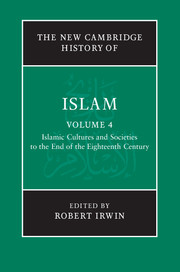Book contents
- Frontmatter
- Introduction
- PART I RELIGION AND LAW
- PART II SOCIETIES, POLITICS AND ECONOMICS
- PART III LITERATURE
- 13 Arabic literature
- 14 Persian literature
- 15 Turkish literature
- 16 Urdu literature
- 17 History writing
- 18 Biographical literature
- 19 Muslim accounts of the dār al-ḥarb
- PART IV LEARNING, ARTS AND CULTURE
- Glossary
- Bibliography
- Index
- References
17 - History writing
from PART III - LITERATURE
Published online by Cambridge University Press: 28 March 2011
- Frontmatter
- Introduction
- PART I RELIGION AND LAW
- PART II SOCIETIES, POLITICS AND ECONOMICS
- PART III LITERATURE
- 13 Arabic literature
- 14 Persian literature
- 15 Turkish literature
- 16 Urdu literature
- 17 History writing
- 18 Biographical literature
- 19 Muslim accounts of the dār al-ḥarb
- PART IV LEARNING, ARTS AND CULTURE
- Glossary
- Bibliography
- Index
- References
Summary
The two Arabic words most commonly associated with ‘history’, taʾrῑkh and khabar (pl. akhbār), reveal conflicting ideas regarding writing about the past. Derived from ancient Near Eastern roots, taʾrῑkh conveys a sense of dating, whereas khabar, meaning ‘story, anecdote’, bears no notion of fixation of time at all. Earlier historical reports were known as akhbār, whereas taʾrῑkh came later to acquire a wider definition of ‘history’ and ‘historical interpretation’. By the end of the second/eighth century most of the works written on history bore the title taʾrῑkh. It was later uniformly adopted into other Islamic languages: Persian, Turkish and Urdu. A massive corpus under the rubric of taʾrῑkh – chronicle, biographical dictionary, administrative geography – was produced over the period in question. Of these, only chronicles will be surveyed here.
The ‘classical’ period (c. 710–1150 CE)
The beginning: ḥadῑth scholars and akhbārῑs
In many ways Islamic history writing began with a ‘clean slate’. While pre-Islamic Arabian inscriptions, poetry and the ayyām al-ʿarab folklore reflect a nostalgic curiosity about the past, the rise of Arabic-Islamic historiography stemmed from a more practical and immediate motivation. Its genesis lay in the early akhbār-reports, which were mostly short and introduced by an isnād, similar to that of the ḥadῑth.
- Type
- Chapter
- Information
- The New Cambridge History of Islam , pp. 444 - 457Publisher: Cambridge University PressPrint publication year: 2010
References
- 3
- Cited by



